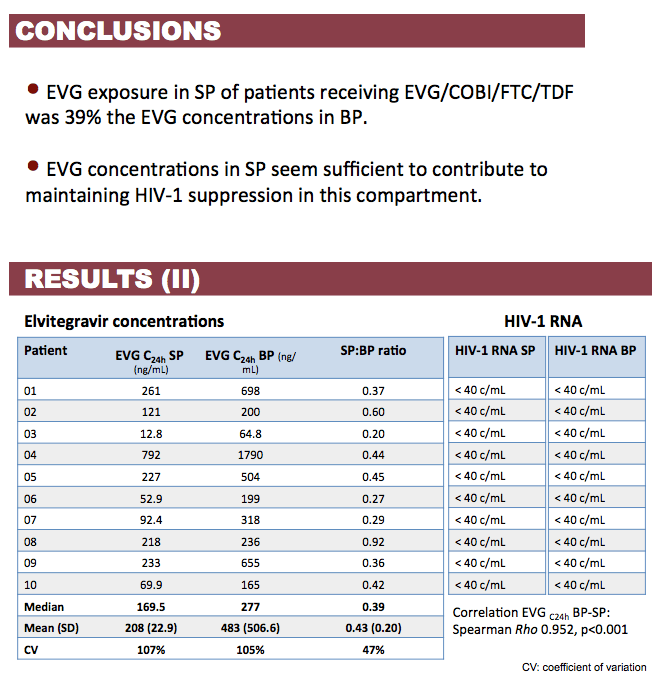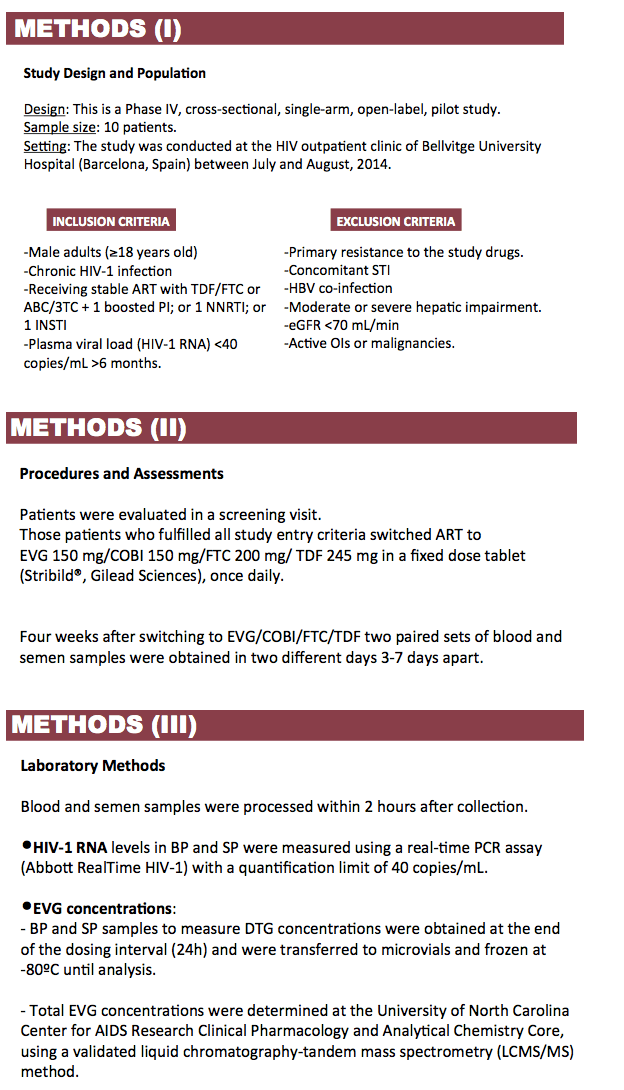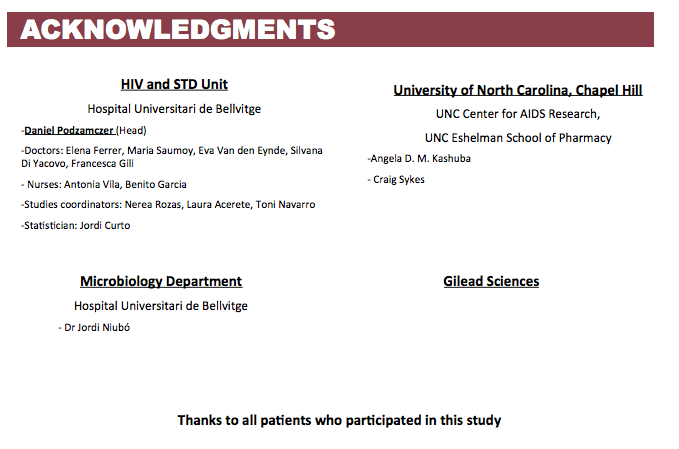 |
 |
 |
| |
Elvitegravir concentrations in seminal plasma
in HIV-1 infected patients
|
| |
| |
Reported by Jules Levin
EACS 2015 Oct 21-24 Barcelona, Spain
Arkaitz Imaz1, Jordi Niubó2, Angela D. M. Kashuba3, Elena Ferrer1, Craig Sykes3,
Nerea Rozas1, Laura Acerete1, Antonia Vila1, Daniel Podzamczer1
1. HIV and STD Unit, Department of Infectious Diseases, Hospital Universitari de Bellvitge, L'Hospitalet de Llobregat, Barcelona, Spain
2. Department of Microbiology, Hospital Universitari de Bellvitge, L'Hospitalet de Llobregat, Barcelona, Spain
3. UNC Center for AIDS Research, UNC Eshelman School of Pharmacy, University of North Carolina at Chapel Hill, Chapel Hill, NC, USA

Program Abstract
Objectives: To quantify elvitegravir concentrations in semen of HIV-1 infected patients receiving antiretroviral therapy (ART) with elvitegravir/cobicistat/emtricitabine/tenofovir (EVG/COBI/FTC/TDF) single tablet regimen.
Methods: Phase IV, cross-sectional study including HIV-1 infected male adults with suppressed plasma HIV-1 RNA who switched ART to EVG/COBI/FTC/TDF. Total EVG concentrations at the end of the dosing interval (C24h), as well as HIV-1 RNA were measured in paired seminal plasma (SP) and blood plasma (BP) samples four weeks after switching to EVG/COBI/FTC/TDF. A validated liquid chromatography-tandem mass spectrometry method was used to quantify EVG concentrations and HIV-1-RNA was determined by real-time PCR (detection limit 40 copies/mL).
Results: Ten patients were included. Median age was 40 years (range 24-47), median time on ART was 50 months (10-186), median time with plasma HIV-1 RNA < 40 copies/mL 37 months (7-113) and median CD4+ T cell count 737 cells/μL (190-1122). No patient was co-infected by HBV or HCV. Previous ART regimens before switching to EVG/COBI/FTC/TDF were TDF/FTC plus darunavir/ritonavir, abacavir/lamivudine + darunavir/ritonavir and TDF/FTC plus etravirine in 5, 4 and 1 individuals, respectively. Four weeks after switching to EVG/COBI/FTC/TDF, HIV-1 RNA was < 40 copies/mL in both BP and SP in all patients. The median EVG C24h in BP was 277 ng/mL (64.8-1790) and in SP 169 ng/mL (12.8-792). EVG C24h in SP was at least 23-fold the in vitro IC50 of HIV-1 clinical isolates (0.04-0.55 ng/mL). In all but one patient EVG C24h in SP was also higher than the blood plasma protein binding-adjusted IC95 of wild type HIV-1 (45 ng/mL). A significant correlation was observed between BP and SP EVG concentrations (Spearman Rho 0.952, p< 0.001). The SP-to-BP EVG concentrations ratio was 39.9% (19.7%-92.4%).
Conclusion: Seminal EVG concentrations in patients treated with EVG/COBI/FTC/TDF were sufficient to contribute to maintaining HIV-1-RNA suppression in this compartment.




In only one patient was SP EVG concentration lower than the blood plasma protein-binding adjusted 95% inhibitory concentration (BP-PA-IC95) for wild-type HIV-1 (45 ng/mL), the pharmacokinetic parameter associated with In only one patient was SP EVG concentration lower than the blood plasma protein-binding adjusted 95% inhibitory concentration (BP-PA-IC95) for wild-type HIV-1 (45 ng/mL), the pharmacokinetic parameter associated with EVG antiviral activity Of note, this patient had the lowest EVG C24h in SP (12.8 ng/mL) and the lowest EVG concentration in BP. Nonetheless, the 12.8 ng/mL SP concentration was 23-fold higher than the in vitro unbound EVG concentration producing 50% effective response (EC50) in HIV-1 clinical isolates (0.04-0.55 ng/mL.

|
| |
|
 |
 |
|
|